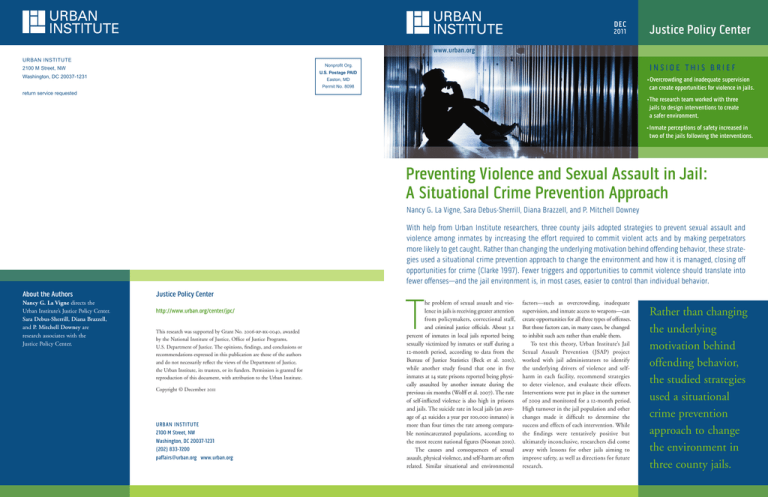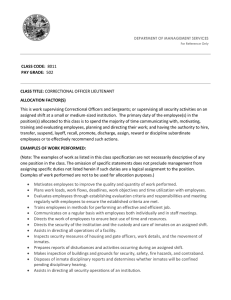
DeC
2011
Justice Policy Center
www.urban.org
UrbaN INstItUtE
Nonprofit Org.
2100 M street, NW
InsIDe thIs brIef
U.S. Postage PAID
Washington, DC 20037-1231
•Overcrowding and inadequate supervision
can create opportunities for violence in jails.
Easton, MD
Permit No. 8098
return service requested
•the research team worked with three
jails to design interventions to create
a safer environment.
•Inmate perceptions of safety increased in
two of the jails following the interventions.
Preventing Violence and sexual Assault in Jail:
A situational Crime Prevention Approach
Nancy G. La Vigne, Sara Debus-Sherrill, Diana Brazzell, and P. Mitchell Downey
With help from Urban Institute researchers, three county jails adopted strategies to prevent sexual assault and
violence among inmates by increasing the effort required to commit violent acts and by making perpetrators
more likely to get caught. Rather than changing the underlying motivation behind offending behavior, these strategies used a situational crime prevention approach to change the environment and how it is managed, closing off
opportunities for crime (Clarke 1997). Fewer triggers and opportunities to commit violence should translate into
fewer offenses—and the jail environment is, in most cases, easier to control than individual behavior.
About the Authors
Nancy G. La Vigne directs the
Urban Institute’s Justice Policy Center.
Sara Debus-Sherrill, Diana Brazzell,
and P. Mitchell Downey are
research associates with the
Justice Policy Center.
Justice Policy Center
http://www.urban.org/center/jpc/
This research was supported by Grant No. 2006-rp-bx-0040, awarded
by the National Institute of Justice, Office of Justice Programs,
U.S. Department of Justice. The opinions, findings, and conclusions or
recommendations expressed in this publication are those of the authors
and do not necessarily reflect the views of the Department of Justice,
the Urban Institute, its trustees, or its funders. Permission is granted for
reproduction of this document, with attribution to the Urban Institute.
Copyright © December 2011
UrbAn InstItUte
2100 M street, nW ●
Washington, DC 20037-1231
(202) 833-7200 ●
paffairs@urban.org ● www.urban.org
T
he problem of sexual assault and violence in jails is receiving greater attention
from policymakers, correctional staff,
and criminal justice officials. About 3.1
percent of inmates in local jails reported being
sexually victimized by inmates or staff during a
12-month period, according to data from the
Bureau of Justice Statistics (Beck et al. 2010),
while another study found that one in five
inmates at 14 state prisons reported being physically assaulted by another inmate during the
previous six months (Wolff et al. 2007). The rate
of self-inflicted violence is also high in prisons
and jails. The suicide rate in local jails (an average of 42 suicides a year per 100,000 inmates) is
more than four times the rate among comparable nonincarcerated populations, according to
the most recent national figures (Noonan 2010).
The causes and consequences of sexual
assault, physical violence, and self-harm are often
related. Similar situational and environmental
factors—such as overcrowding, inadequate
supervision, and inmate access to weapons—can
create opportunities for all three types of offenses.
But those factors can, in many cases, be changed
to inhibit such acts rather than enable them.
To test this theory, Urban Institute’s Jail
Sexual Assault Prevention (JSAP) project
worked with jail administrators to identify
the underlying drivers of violence and selfharm in each facility, recommend strategies
to deter violence, and evaluate their effects.
Interventions were put in place in the summer
of 2009 and monitored for a 12-month period.
High turnover in the jail population and other
changes made it difficult to determine the
success and effects of each intervention. While
the findings were tentatively positive but
ultimately inconclusive, researchers did come
away with lessons for other jails aiming to
improve safety, as well as directions for future
research.
Rather than changing
the underlying
motivation behind
offending behavior,
the studied strategies
used a situational
crime prevention
approach to change
the environment in
three county jails.
Preventing Violence and sexual Assault in Jail: A situational Crime Prevention Approach
Project sites
The three jails, all of which rank within the
nation’s top 30 largest systems, worked closely
with the research team to choose different
avenues to improve safety. Selected interventions
were guided by analyses of site observations; staff
and inmate interviews and surveys; and reported
incidents of violence, weapons and contraband,
and staff use of force. Site A adopted an electronic system to track officers’ rounds, Site B
installed cameras to reduce blind spots and
record evidence for investigations, and Site C
trained officers in crisis intervention to help
improve their interactions with inmates and
their ability to identify and prevent violent acts
before they occur.
site A: Improving supervision
At Site A, inconsistent supervision by corrections officers was creating opportunities for
inmates to engage in violence and other prohibited acts. The jail design inhibited officers from
interacting with inmates, and mechanisms were
not in place to ensure that officers were conducting their rounds as often as prescribed. In
response, jail administrators installed sensor
buttons around the facility that tracked officers’
rounds with a device officers carried. Sergeants
reviewed the data for each shift to hold the officers accountable. The thinking was that the
tracking system would prompt more consistent
supervision, which in turn would make inmates
reconsider assaulting another inmate because
the risk of getting caught by officers conducting
their rounds would be greater.
Staff opinions about the system mostly
varied by rank—line officers tended to dislike
it, while supervisors had more positive opinions about the system’s role in jail management.
Some thought the greater adherence to conducting rounds contributed little and that the
rounds weren’t carefully conducted. Inmate
perceptions were mixed, but many inmates
surveyed after the officer tracking system was
installed felt that there was less violence in the
recreation area, less contraband, and greater
overall safety. The picture from incident
reports, however, was inconclusive due to
2.
conflicting results, limitations in the data, and
changes at the jail unrelated to the officer
tracking system. However, analyses did find
fewer incidents in which officers used force,
suggesting that more routine contact with
inmates may have affected how officers
responded to threats or altercations.
The tracking system cost $25,365 for
equipment, infrastructure, and installation.
Because the site incorporated new staff
responsibilities into existing schedules, they
incurred no additional labor costs. However,
staff time spent on the intervention amounted
to about $191,999 across the intervention
period—a cost that other jails should include
in their planning estimates if they choose to
install an officer tracking system.
In the first 12 months of using the system,
175 fewer instances of use of force were
reported, although it is unclear to what extent
these changes were related to the new tracking
system. It is possible, for example, that actual
violent incidents went down at the same time
that detection went up, masking the true effect
of deterrence. Overall, the officer tour system’s
effect on safety is uncertain.
site b: Installing surveillance Cameras
Site B also aimed for greater surveillance and
accountability to deter violence. Surveillance
cameras were installed to reduce blind spots in
housing units, particularly in areas identified as
high risk for violence and suicide attempts.
The cameras had an added benefit of recording
evidence for incident investigations and monitoring staff conduct. Video footage was viewed
for every incident, and randomly selected
footage was reviewed every month.
In terms of perceptions of the cameras’
effectiveness, staff opinions varied by rank. Jail
leadership and management were mostly in
favor of the cameras, while line officers had
more negative opinions and perceived that the
cameras were used to monitor their own
behavior as opposed to that of the inmates.
Both staff and inmates, however, felt the
cameras provided useful impartial evidence for
investigation purposes.
When surveyed after the new cameras were
installed, fewer inmates believed that consensual
and forced sexual activity were likely to occur
compared with surveys of inmates conducted
before the cameras were put in place. Violence
was also perceived as less likely to occur, and a
smaller percentage of inmates reported being
threatened or getting involved in fights. However,
inmates were unsure whether the cameras
increased safety overall, and the analysis of the
incident reports was inconclusive. Although no
change in incidents was detected, it is possible
that, as with Site A, the effects of greater detection masked a reduction in violent incidents.
The camera equipment, infrastructure, and
installation cost $54,740, while labor costs
for planning the system and reviewing footage
were estimated to be another $30,260. However,
Site B saved on labor costs because no new
employees were hired and the facility was able
to fold new camera monitoring responsibilities
into existing labor hours.
site C: training Officers in Crisis
Intervention
Site C took a different path, choosing to train
officers in crisis intervention and educate them
about mental illness, suicide, and sexual assault.
By improving officers’ interactions with inmates,
Site C aimed to reduce inmates’ stress and frustration and to cut down on confrontations that
might provoke inmates to act violently. Officers
were taught how to resolve intense situations
calmly and nonviolently and how to recognize
and respond to symptoms of mental illness,
self-harm, and sexual victimization. This strategy was a good fit for Site C because the jail was
primarily used to house inmates requiring medications and many of those inmates had mental
health issues.
During the evaluation period, the inmate
population changed significantly, as Site C
switched from holding maximum security
inmates to primarily holding inmates who
required daily medications. Because of this
change, incident reports and inmate surveys
could not be used to gauge the training’s
effectiveness. Instead, researchers analyzed
surveys of corrections officers who participated
in the training, interviews with jail management
and line staff, and observations of the training.
Overall, participants believed the training
was positive and recommended it for other corrections officers. The survey analysis found that
the training increased participants’ confidence
in knowing how to respond to problems and
improved attitudes and knowledge related to
sexual assault, mental health, and suicide and
self-harm. Some staff perceived that inmates
became more compliant as a result of better
interactions with officers.
Without incident reports and inmate interviews, it is unclear whether the training reduced
violence in Site C’s jail and it was not possible
to conduct a cost-effectiveness analysis. The
findings suggest, though, that crisis intervention
training is a promising strategy to help corrections officers defuse potentially violent situations.
recommendations
One overarching theme that emerged was the
importance of correctional staff. Indeed, the
success of any intervention ultimately rests on
staff ’s ability to conduct their jobs with consistency, accountability, and professionalism.
Many of the recommendations distilled from
this study represent sound operating practices
in prisons and jails, and others offer insights
on how to identify the underlying causes of
violence and develop ways to address them
within the larger context of the jail culture:
• When considering new safety interventions,
rely on a four-step process: (1) analyze
the dates, times, locations, and contexts
surrounding previous incidents to identify
what factors are related to violence;
(2) use evidence-based strategies to address
the jail’s particular needs and vulnerabilities;
(3) fit those strategies into an overall system
of best practices for classifying, supervising,
and managing inmates and designing jails;
and (4) continually evaluate the intervention
and make changes as needed.
• When developing strategies to reduce
violence, keep in mind that the causes, contextual factors, and opportunities to commit
violent acts may differ by the type of violence
or type of population (e.g., women versus
men). Targeted interventions may be required.
• Working in a real-life setting has its benefits
and challenges. Researchers should be
prepared for the unexpected changes, data
collection limitations, and other setbacks
that come with testing strategies in correctional settings.
• Inmates said cells were high-risk locations
for violence and contraband. Cells are the
only places not under constant supervision or
surveillance, and privacy requirements restrict
jails from putting cameras in cells. Cameras
can, however, be positioned to record
who goes in and out of cells when inmates
are in the dayrooms. A more constant officer
presence—either through more frequent
rounds or through direct supervision—may
also improve safety.
As with many evaluations, this study raises more
questions than it answers and cannot conclude
with certainty how effective the interventions
were. That said, all three strategies were related
to positive changes in how staff and inmates
perceived safety and how staff performed their
jobs. Furthermore, all three were guided by a
thorough analysis of each jail’s weaknesses and
how they could be strengthened. Overall, the
findings offer lessons for researchers, practitioners, and policymakers about creating safer jails
and suggest that situational crime prevention
may be a useful tool in correctional settings. •
• Physical and sexual violence are often interconnected, so assessing both is important.
Also, inmates perceive—and incident data
appear to confirm—that physical violence
is more likely than sexual assault.
• Preventing contraband can greatly reduce
violence. Focusing on this issue should also
help address staff misconduct, as contraband
is often a sign of security breaches.
The full report “Evaluation of a Situational
Crime Prevention Approach in Three Jails: The
Jail Sexual Assault Prevention Project” is available
at http://www.urban.org/url.cfm?ID=412394.
references
Beck, Allen J., Paige M. Harrison, Marcus Berzofsky,
• Corrections administrators should adopt a
zero tolerance policy regarding staff sexual
misconduct and consensual sex between
inmates. Both are potential triggers for
violence and can mask more serious sexual
coercion or force.
• Inmates’ inability to get medicine or mental
health care could lead to violence or self-harm,
so jails should improve the quality of and
access to correctional health care.
Rachel Caspar, and Christopher Krebs. 2010.
“Sexual Victimization in Prisons and Jails Reported
by Inmates, 2008–2009.” NCJ 231169. Washington,
D.C.: U.S. Department of Justice, Bureau of
Justice Statistics.
Clarke, Ronald V. 1997. “Introduction.” In
Situational Crime Prevention: Successful Case Studies,
2nd edition, edited by Ronald V. Clarke, 1-43.
Monsey, NY: Criminal Justice Press.
Noonan, Margaret. 2010. “Mortality in Local Jails,
2000–2007.” NCJ 222988. Washington, D.C.: U.S.
• When asked what changes could lead to a
safer jail environment, inmates consistently
recommended improving the quality of staff.
Corrections administrators should seek ways
to train and motivate officers to act professionally and should develop and implement
accountability and performance measures.
Department of Justice, Bureau of Justice Statistics.
Wolff, Nancy, Cynthia L. Blitz, Jing Shi, Jane Siegel,
and Ronet Bachman. 2007. “Physical Violence inside
Prisons: Rates of Victimization.” Criminal Justice
and Behavior 34(5): 588–99.
3.
Preventing Violence and sexual Assault in Jail: A situational Crime Prevention Approach
Project sites
The three jails, all of which rank within the
nation’s top 30 largest systems, worked closely
with the research team to choose different
avenues to improve safety. Selected interventions
were guided by analyses of site observations; staff
and inmate interviews and surveys; and reported
incidents of violence, weapons and contraband,
and staff use of force. Site A adopted an electronic system to track officers’ rounds, Site B
installed cameras to reduce blind spots and
record evidence for investigations, and Site C
trained officers in crisis intervention to help
improve their interactions with inmates and
their ability to identify and prevent violent acts
before they occur.
site A: Improving supervision
At Site A, inconsistent supervision by corrections officers was creating opportunities for
inmates to engage in violence and other prohibited acts. The jail design inhibited officers from
interacting with inmates, and mechanisms were
not in place to ensure that officers were conducting their rounds as often as prescribed. In
response, jail administrators installed sensor
buttons around the facility that tracked officers’
rounds with a device officers carried. Sergeants
reviewed the data for each shift to hold the officers accountable. The thinking was that the
tracking system would prompt more consistent
supervision, which in turn would make inmates
reconsider assaulting another inmate because
the risk of getting caught by officers conducting
their rounds would be greater.
Staff opinions about the system mostly
varied by rank—line officers tended to dislike
it, while supervisors had more positive opinions about the system’s role in jail management.
Some thought the greater adherence to conducting rounds contributed little and that the
rounds weren’t carefully conducted. Inmate
perceptions were mixed, but many inmates
surveyed after the officer tracking system was
installed felt that there was less violence in the
recreation area, less contraband, and greater
overall safety. The picture from incident
reports, however, was inconclusive due to
2.
conflicting results, limitations in the data, and
changes at the jail unrelated to the officer
tracking system. However, analyses did find
fewer incidents in which officers used force,
suggesting that more routine contact with
inmates may have affected how officers
responded to threats or altercations.
The tracking system cost $25,365 for
equipment, infrastructure, and installation.
Because the site incorporated new staff
responsibilities into existing schedules, they
incurred no additional labor costs. However,
staff time spent on the intervention amounted
to about $191,999 across the intervention
period—a cost that other jails should include
in their planning estimates if they choose to
install an officer tracking system.
In the first 12 months of using the system,
175 fewer instances of use of force were
reported, although it is unclear to what extent
these changes were related to the new tracking
system. It is possible, for example, that actual
violent incidents went down at the same time
that detection went up, masking the true effect
of deterrence. Overall, the officer tour system’s
effect on safety is uncertain.
site b: Installing surveillance Cameras
Site B also aimed for greater surveillance and
accountability to deter violence. Surveillance
cameras were installed to reduce blind spots in
housing units, particularly in areas identified as
high risk for violence and suicide attempts.
The cameras had an added benefit of recording
evidence for incident investigations and monitoring staff conduct. Video footage was viewed
for every incident, and randomly selected
footage was reviewed every month.
In terms of perceptions of the cameras’
effectiveness, staff opinions varied by rank. Jail
leadership and management were mostly in
favor of the cameras, while line officers had
more negative opinions and perceived that the
cameras were used to monitor their own
behavior as opposed to that of the inmates.
Both staff and inmates, however, felt the
cameras provided useful impartial evidence for
investigation purposes.
When surveyed after the new cameras were
installed, fewer inmates believed that consensual
and forced sexual activity were likely to occur
compared with surveys of inmates conducted
before the cameras were put in place. Violence
was also perceived as less likely to occur, and a
smaller percentage of inmates reported being
threatened or getting involved in fights. However,
inmates were unsure whether the cameras
increased safety overall, and the analysis of the
incident reports was inconclusive. Although no
change in incidents was detected, it is possible
that, as with Site A, the effects of greater detection masked a reduction in violent incidents.
The camera equipment, infrastructure, and
installation cost $54,740, while labor costs
for planning the system and reviewing footage
were estimated to be another $30,260. However,
Site B saved on labor costs because no new
employees were hired and the facility was able
to fold new camera monitoring responsibilities
into existing labor hours.
site C: training Officers in Crisis
Intervention
Site C took a different path, choosing to train
officers in crisis intervention and educate them
about mental illness, suicide, and sexual assault.
By improving officers’ interactions with inmates,
Site C aimed to reduce inmates’ stress and frustration and to cut down on confrontations that
might provoke inmates to act violently. Officers
were taught how to resolve intense situations
calmly and nonviolently and how to recognize
and respond to symptoms of mental illness,
self-harm, and sexual victimization. This strategy was a good fit for Site C because the jail was
primarily used to house inmates requiring medications and many of those inmates had mental
health issues.
During the evaluation period, the inmate
population changed significantly, as Site C
switched from holding maximum security
inmates to primarily holding inmates who
required daily medications. Because of this
change, incident reports and inmate surveys
could not be used to gauge the training’s
effectiveness. Instead, researchers analyzed
surveys of corrections officers who participated
in the training, interviews with jail management
and line staff, and observations of the training.
Overall, participants believed the training
was positive and recommended it for other corrections officers. The survey analysis found that
the training increased participants’ confidence
in knowing how to respond to problems and
improved attitudes and knowledge related to
sexual assault, mental health, and suicide and
self-harm. Some staff perceived that inmates
became more compliant as a result of better
interactions with officers.
Without incident reports and inmate interviews, it is unclear whether the training reduced
violence in Site C’s jail and it was not possible
to conduct a cost-effectiveness analysis. The
findings suggest, though, that crisis intervention
training is a promising strategy to help corrections officers defuse potentially violent situations.
recommendations
One overarching theme that emerged was the
importance of correctional staff. Indeed, the
success of any intervention ultimately rests on
staff ’s ability to conduct their jobs with consistency, accountability, and professionalism.
Many of the recommendations distilled from
this study represent sound operating practices
in prisons and jails, and others offer insights
on how to identify the underlying causes of
violence and develop ways to address them
within the larger context of the jail culture:
• When considering new safety interventions,
rely on a four-step process: (1) analyze
the dates, times, locations, and contexts
surrounding previous incidents to identify
what factors are related to violence;
(2) use evidence-based strategies to address
the jail’s particular needs and vulnerabilities;
(3) fit those strategies into an overall system
of best practices for classifying, supervising,
and managing inmates and designing jails;
and (4) continually evaluate the intervention
and make changes as needed.
• When developing strategies to reduce
violence, keep in mind that the causes, contextual factors, and opportunities to commit
violent acts may differ by the type of violence
or type of population (e.g., women versus
men). Targeted interventions may be required.
• Working in a real-life setting has its benefits
and challenges. Researchers should be
prepared for the unexpected changes, data
collection limitations, and other setbacks
that come with testing strategies in correctional settings.
• Inmates said cells were high-risk locations
for violence and contraband. Cells are the
only places not under constant supervision or
surveillance, and privacy requirements restrict
jails from putting cameras in cells. Cameras
can, however, be positioned to record
who goes in and out of cells when inmates
are in the dayrooms. A more constant officer
presence—either through more frequent
rounds or through direct supervision—may
also improve safety.
As with many evaluations, this study raises more
questions than it answers and cannot conclude
with certainty how effective the interventions
were. That said, all three strategies were related
to positive changes in how staff and inmates
perceived safety and how staff performed their
jobs. Furthermore, all three were guided by a
thorough analysis of each jail’s weaknesses and
how they could be strengthened. Overall, the
findings offer lessons for researchers, practitioners, and policymakers about creating safer jails
and suggest that situational crime prevention
may be a useful tool in correctional settings. •
• Physical and sexual violence are often interconnected, so assessing both is important.
Also, inmates perceive—and incident data
appear to confirm—that physical violence
is more likely than sexual assault.
• Preventing contraband can greatly reduce
violence. Focusing on this issue should also
help address staff misconduct, as contraband
is often a sign of security breaches.
The full report “Evaluation of a Situational
Crime Prevention Approach in Three Jails: The
Jail Sexual Assault Prevention Project” is available
at http://www.urban.org/url.cfm?ID=412394.
references
Beck, Allen J., Paige M. Harrison, Marcus Berzofsky,
• Corrections administrators should adopt a
zero tolerance policy regarding staff sexual
misconduct and consensual sex between
inmates. Both are potential triggers for
violence and can mask more serious sexual
coercion or force.
• Inmates’ inability to get medicine or mental
health care could lead to violence or self-harm,
so jails should improve the quality of and
access to correctional health care.
Rachel Caspar, and Christopher Krebs. 2010.
“Sexual Victimization in Prisons and Jails Reported
by Inmates, 2008–2009.” NCJ 231169. Washington,
D.C.: U.S. Department of Justice, Bureau of
Justice Statistics.
Clarke, Ronald V. 1997. “Introduction.” In
Situational Crime Prevention: Successful Case Studies,
2nd edition, edited by Ronald V. Clarke, 1-43.
Monsey, NY: Criminal Justice Press.
Noonan, Margaret. 2010. “Mortality in Local Jails,
2000–2007.” NCJ 222988. Washington, D.C.: U.S.
• When asked what changes could lead to a
safer jail environment, inmates consistently
recommended improving the quality of staff.
Corrections administrators should seek ways
to train and motivate officers to act professionally and should develop and implement
accountability and performance measures.
Department of Justice, Bureau of Justice Statistics.
Wolff, Nancy, Cynthia L. Blitz, Jing Shi, Jane Siegel,
and Ronet Bachman. 2007. “Physical Violence inside
Prisons: Rates of Victimization.” Criminal Justice
and Behavior 34(5): 588–99.
3.
DeC
2011
Justice Policy Center
www.urban.org
UrbaN INstItUtE
Nonprofit Org.
2100 M street, NW
InsIDe thIs brIef
U.S. Postage PAID
Washington, DC 20037-1231
•Overcrowding and inadequate supervision
can create opportunities for violence in jails.
Easton, MD
Permit No. 8098
return service requested
•the research team worked with three
jails to design interventions to create
a safer environment.
•Inmate perceptions of safety increased in
two of the jails following the interventions.
Preventing Violence and sexual Assault in Jail:
A situational Crime Prevention Approach
Nancy G. La Vigne, Sara Debus-Sherrill, Diana Brazzell, and P. Mitchell Downey
With help from Urban Institute researchers, three county jails adopted strategies to prevent sexual assault and
violence among inmates by increasing the effort required to commit violent acts and by making perpetrators
more likely to get caught. Rather than changing the underlying motivation behind offending behavior, these strategies used a situational crime prevention approach to change the environment and how it is managed, closing off
opportunities for crime (Clarke 1997). Fewer triggers and opportunities to commit violence should translate into
fewer offenses—and the jail environment is, in most cases, easier to control than individual behavior.
About the Authors
Nancy G. La Vigne directs the
Urban Institute’s Justice Policy Center.
Sara Debus-Sherrill, Diana Brazzell,
and P. Mitchell Downey are
research associates with the
Justice Policy Center.
Justice Policy Center
http://www.urban.org/center/jpc/
This research was supported by Grant No. 2006-rp-bx-0040, awarded
by the National Institute of Justice, Office of Justice Programs,
U.S. Department of Justice. The opinions, findings, and conclusions or
recommendations expressed in this publication are those of the authors
and do not necessarily reflect the views of the Department of Justice,
the Urban Institute, its trustees, or its funders. Permission is granted for
reproduction of this document, with attribution to the Urban Institute.
Copyright © December 2011
UrbAn InstItUte
2100 M street, nW ●
Washington, DC 20037-1231
(202) 833-7200 ●
paffairs@urban.org ● www.urban.org
T
he problem of sexual assault and violence in jails is receiving greater attention
from policymakers, correctional staff,
and criminal justice officials. About 3.1
percent of inmates in local jails reported being
sexually victimized by inmates or staff during a
12-month period, according to data from the
Bureau of Justice Statistics (Beck et al. 2010),
while another study found that one in five
inmates at 14 state prisons reported being physically assaulted by another inmate during the
previous six months (Wolff et al. 2007). The rate
of self-inflicted violence is also high in prisons
and jails. The suicide rate in local jails (an average of 42 suicides a year per 100,000 inmates) is
more than four times the rate among comparable nonincarcerated populations, according to
the most recent national figures (Noonan 2010).
The causes and consequences of sexual
assault, physical violence, and self-harm are often
related. Similar situational and environmental
factors—such as overcrowding, inadequate
supervision, and inmate access to weapons—can
create opportunities for all three types of offenses.
But those factors can, in many cases, be changed
to inhibit such acts rather than enable them.
To test this theory, Urban Institute’s Jail
Sexual Assault Prevention (JSAP) project
worked with jail administrators to identify
the underlying drivers of violence and selfharm in each facility, recommend strategies
to deter violence, and evaluate their effects.
Interventions were put in place in the summer
of 2009 and monitored for a 12-month period.
High turnover in the jail population and other
changes made it difficult to determine the
success and effects of each intervention. While
the findings were tentatively positive but
ultimately inconclusive, researchers did come
away with lessons for other jails aiming to
improve safety, as well as directions for future
research.
Rather than changing
the underlying
motivation behind
offending behavior,
the studied strategies
used a situational
crime prevention
approach to change
the environment in
three county jails.





